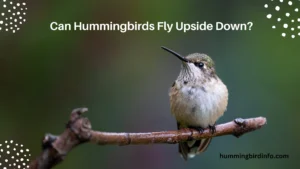Hummingbirds are tiny, dazzling birds known for their remarkable ability to hover mid-air, flitting from flower to flower with effortless grace.
With wings that beat up to 80 times per second, they seem like creatures that never pause. Their presence feels like a constant blur of motion, fascinating birdwatchers and nature lovers alike.
But do hummingbirds ever stop flying? Many assume they are always in motion, especially since they are often seen darting and hovering rather than resting. The truth is far more intriguing and reveals just how adaptable and intelligent these creatures are when it comes to survival.
This article will explore the science behind stopping in hummingbirds—how they rest, perch, conserve energy, and survive without flapping nonstop. Understanding when and how they stop flying gives us a deeper appreciation of their biology, behavior, and evolutionary design.
Let’s dive into their world of motion, and stillness.
Contents
The Mechanics of Hummingbird Flight
Hummingbirds have a unique wing structure that allows them to move in ways no other birds can. Their wings rotate in a figure-eight pattern, generating lift on both the upstroke and downstroke. This motion is what makes their hovering flight possible.
Their wings beat up to 80 times per second, depending on the species. This requires incredible muscle power, especially from their pectoral muscles which account for over 25% of their body weight. These muscles are specially designed for precision and speed in flight.
To support this, hummingbirds have the highest metabolic rate among warm-blooded animals. They rely on a constant supply of nectar and insects to fuel their movements. Even a few hours without food can cause energy depletion.
They are also highly maneuverable, capable of flying backwards, hovering, and making rapid directional changes. But they don’t just fly without control—they can stop mid-air by adjusting wing angles and muscle force with amazing accuracy.
Stopping isn’t just falling—they decelerate using their tail feathers and wing resistance, managing balance and safety. Their bodies are built not only for movement but also for stillness with control.
Reasons Why Hummingbirds Stop Flying
Hummingbirds perch frequently to rest their exhausted wings. They find thin branches or wires and cling tightly with their feet, allowing their tiny bodies to recover. Perching is a vital part of their daily rhythm.
During feeding, they may either hover or perch depending on the feeder or flower structure. While hovering is common, perching conserves energy, especially during long feeding sessions. Their tongues do most of the work in drawing up nectar.
They also stop flying to groom and preen. This process keeps their feathers clean and aerodynamic. Without regular preening, flight becomes less efficient and insulation is compromised.
For female hummingbirds, nesting involves long periods of stillness. They stop flying to construct, incubate, and feed their young. Nest duties are energy-intensive but require total stillness to maintain warmth and care.
Another reason for stopping is entering torpor, a deep sleep-like state. In torpor, their heart rate, breathing, and temperature drop to extreme lows, helping them survive cold nights or food shortages.
Physiological Adaptations for Resting
Hummingbirds may be aerial experts, but they have adaptations for perching too. Their feet are small but equipped with strong tendons that lock in place, allowing secure gripping even during sleep.
While flying, their heart rate can hit over 1,200 beats per minute, but while perched, it slows dramatically. Their respiratory system also adjusts, reducing oxygen demand and allowing restorative pauses.
They store energy in the form of fat, particularly before migration. This reserve helps them stay aloft for long periods and recover when they finally stop. Their body knows how to balance high output with efficient storage.

During torpor, their internal systems go into low-power mode. Their metabolism can drop by 95%, essentially placing them in a state of temporary hibernation. Waking up takes time but preserves vital resources.
These physiological changes are not weaknesses—they’re evolutionary solutions that keep hummingbirds alive in a demanding, high-speed world.
Hummingbird Behavior When Not Flying
Hummingbirds choose their perches carefully, preferring shaded spots with good visibility. These perches offer rest and safety while keeping an eye out for intruders or predators.
They often return to the same perches daily, making them part of their routine. While perched, they perform maintenance like stretching, vocalizing, or watching their surroundings with keen alertness.
Despite being solitary birds, some species show territorial aggression even while perched. They guard feeders or flowers, issuing warning calls or engaging in short aerial chases.
They also vocalize while resting, especially males during the breeding season. These chirps and buzzes help establish territory and attract mates, all while their wings are still.
Though they seem built for nonstop action, hummingbirds have a daily rhythm of activity, rest, and renewal that keeps them agile and strong.
The Importance of Stopping – Energy Conservation
Flying costs hummingbirds an enormous amount of energy, more than almost any other bird. Their bodies are constantly burning calories just to stay airborne.
Resting helps balance this high output with essential recovery. Without perching or torpor, hummingbirds would burn out quickly, especially during migration or cold weather.
Being able to stop flying is not just a luxury—it’s a survival tool. It allows hummingbirds to store energy, survive tough conditions, and live longer in a demanding environment.
Conclusion:
While hummingbirds may be icons of constant motion, their ability to stop flying is equally remarkable. From perching quietly to entering deep torpor, they’ve evolved to balance energy output with smart recovery.
This ability to pause, rest, and conserve energy is just as vital as their flight. It reflects a life shaped by the extremes of speed, precision, and adaptability.
In a world where movement often takes the spotlight, hummingbirds remind us that stillness is powerful too. Their tiny bodies hold lessons in efficiency, balance, and the beauty of adaptation.
FAQ’s
1. Can hummingbirds land and sit still?
Yes, they can perch and remain motionless for long periods, especially when resting or nesting.
2. How do hummingbirds rest at night?
They usually perch on a safe branch and may even enter torpor, a state similar to deep sleep.
3. Do hummingbirds sleep while flying?
No, hummingbirds must stop flying to sleep, unlike some other bird species like swifts.
4. How long can hummingbirds stay in flight?
They can fly for hours but must stop several times a day to feed, groom, or rest.
5. What happens if a hummingbird can’t stop flying?
They would suffer from exhaustion or energy depletion and may not survive without rest.
6. Do they perch while feeding?
Yes, some feeders or flowers allow them to perch while sipping nectar, which helps conserve energy.








